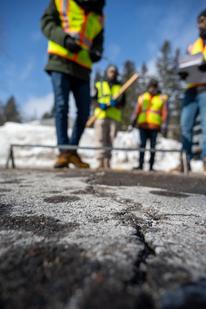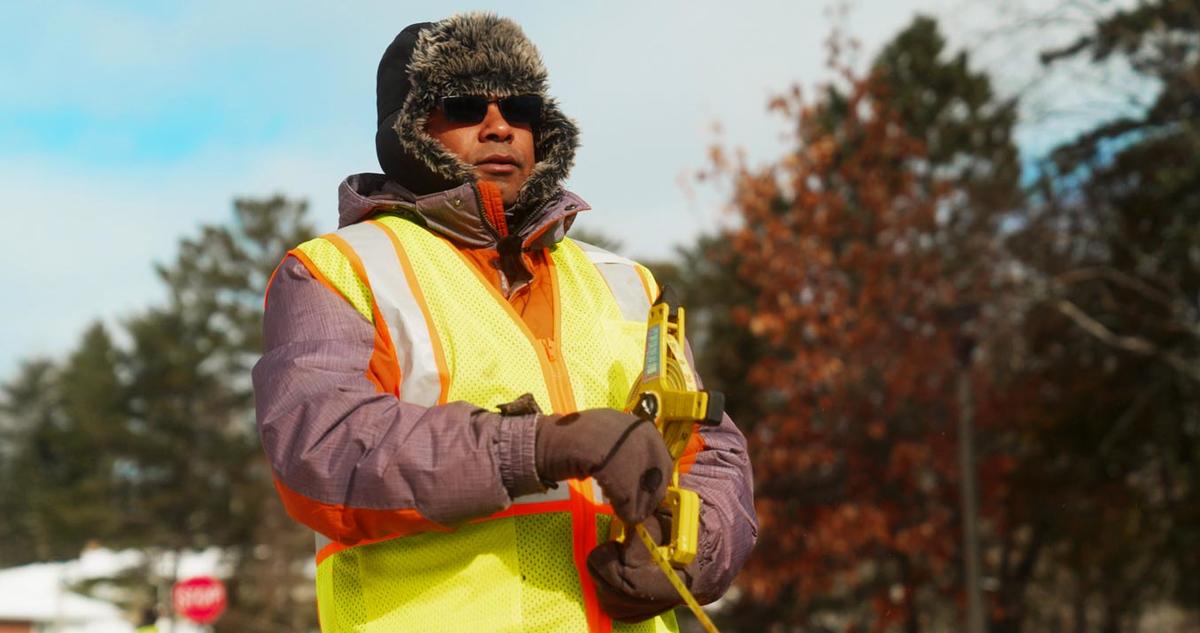Manik Barman, Ph.D., an associate professor in the Swenson College of Science and Engineering at UMD and a scholar with the Center for Transportation Studies, discusses what causes potholes, the work that goes into fixing them and how drivers can stay safe on uneven roads.
Q: What causes potholes?

Barman: Minnesota’s roads experience harsh weather conditions. Severely cold temperatures, heavy snowfall, freeze-thaw cycles and de-icing salt significantly influences the roads of Minnesota.
In general, potholes are secondary distress, mostly the end result of other structural distresses caused by traffic load or material weathering. In areas like Minnesota, the weather plays the dominant role especially for moderate and low-volume roads. The water that infiltrates the pavement structure transforms into ice in the winter and creates micro-cracks in the asphalt layer. In the spring when the ice thaws, those cracks propagate and disintegrate the asphalt materials under the vehicle load and create potholes. The loss of support underneath the asphalt layer for melting ice and the effect of de-icing salt, age and condition of the pavement have effects on the pothole formation, propagation and severity.
Q: How are potholes patched?
Barman: Potholes require rapid repair action for the safety of road users. Different patching methods and materials are available. In the winter, potholes are temporarily patched using a cold mix until more permanent patching methods can be applied. Patching with hot mixes is generally performed in non-winter seasons. Conventional asphalt mixes, slurry mixes and mastic patching materials are used.
Q: Have the methods used to patch roads changed over the past few decades? If so, what innovations have been made?
Barman: In recent years, innovations have been made in both methods and materials. On-site patching material mixers and installation equipment have been made to produce hot asphalt-based patching mixes, which can now be used in the winter as well. Equipment is available to heat the existing materials around the pothole which enhances the bonding of the existing asphalt material to the patching material, leading to a better service life. Among the new patching materials, UMD’s taconite-based patching material is a fast-setting patching material that can last significantly longer, and can be applied more easily in winter.
Q: What do you think Minnesotans should know — but might not already — when it comes to potholes?
Barman: Driving on pothole-infested roads is frustrating and hazardous. This is why transportation agencies take initiative to mitigate potholes, including implementing preventive maintenance and periodical repair works. However, it is safe to assume that the harsh weather conditions — especially the freeze-thaw cycle — will keep creating potholes.
The following are some tips for handling potholes this spring:
- Expect potholes and drive slowly and cautiously.
- Consider scheduling in extra driving time.
- Watch for vehicle damage after driving on potholes.
- Report pothole occurrences to transportation agencies (city, county and/or MnDOT District as appropriate) as soon as possible.
- Try to keep calm when dealing with road difficulties, remembering that we live in an area that has harsh weather which impacts the roads.
Q: What work are you doing to advance road maintenance techniques and technology?
Barman: “Better roads” is the theme of my research. I conduct research on creating innovative and sustainable pavement materials and designs, rehabilitation and maintenance. The pothole patching guide and decision framework I developed is currently used in Minnesota to select the most-effective patching method as a function of the season, shape and size of the potholes. Agencies now have flash cards to select the appropriate patching method based on the pothole features. In another research, I determined the most cost-effective pavement crack sealing method for Minnesota roads, which is awaiting implementation. Appropriate sealing of cracks can decrease the moisture infiltration to the pavement structure, which can negate the effect of freeze-thaw cycles that creates potholes. One of my recent projects focuses on developing better-performing asphalt mixtures for low-volume roads in Minnesota to decrease weather-induced distresses.
Manik Barman, Ph.D., is an associate professor in the Swenson College of Science and Engineering at UMD and a scholar with the Center for Transportation Studies. His scholarly focus is on pavement design, rehabilitation and maintenance. He is currently researching pavement rehabilitation and maintenance issues, fiber reinforced concretes for long-lasting pavement rehabilitation and asphalt mixtures for low volume roads.
